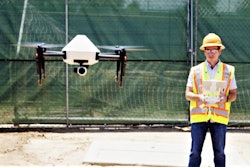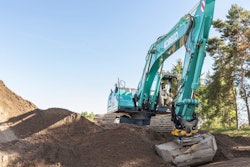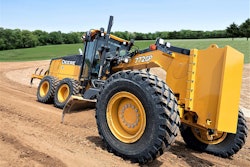Editor’s Note: This is part one of a two-part series on Komatsu‘s Smart Construction technology consultancy service. To read part two, which discusses the expansion of the service and how the company is optimizing the jobsite through 3D modeling and drone services, click here.
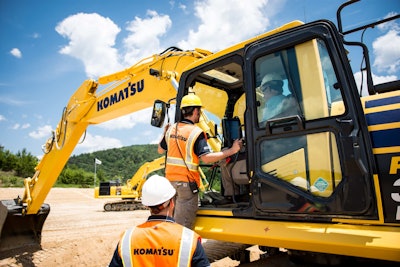 Komatsu’s TSE’s will assist contractors and operators with all facets of GPS/GNSS machine operation. Photo: Wayne Grayson
Komatsu’s TSE’s will assist contractors and operators with all facets of GPS/GNSS machine operation. Photo: Wayne GraysonWhen Komatsu introduced Smart Construction here in the States two years ago, it was actually the second launch of the service.
The first occurred a year earlier in the company’s home country of Japan, where the world’s No. 2 heavy equipment manufacturer began offering a fully-automated site preparation service. The company runs machines equipped with fully-integrated GPS/GNSS machine control in full-auto with little assistance or interference by operators, using site data provided by drones and 3D laser scanners. Since the launch, the service has grown quickly and has been used on more than 5,500 Japanese jobsites. The Japanese service has added 1,500 jobsites in the past seven months alone, and recently launched a new option called EverydayDrone for those customers who only require drone surveys.
But for the American service, the offering was slightly different. In the States, the primary focus of the new initiative was customer support. Namely, offering comprehensive support for intelligent machine control (iMC), which in the U.S. are all run by operators in a semi-auto configuration: hands on the controls but taking advantage of the time savings and precise cuts machine control provides.
Though it appears that Komatsu has launched two completely different businesses—an automated site prep service in Japan and an AppleCare-like service for intelligent earthmovers here in the U.S., there is now more commonality between the U.S. and Japanese versions than there may appear.
While Komatsu America does not currently have plans to launch a site prep service in the States, there has been a subtle evolution of the U.S. version of Smart Construction in the two years since its official launch. As Komatsu’s Chris Faulhaber explains it, the primary difference between the two versions of the service is execution. The overall goal of Smart Construction he says, is the same in both countries.
Leveling the playing field
Faulhaber is the Smart Construction business manager at Komatsu Equipment in Salt Lake City, one of six dealerships owned by Komatsu America. Hired three years ago as the first Smart Construction business manager in Komatsu’s system, his work on the service pre-dates the official U.S. launch.
“The real emphasis of Smart Construction is more the partnership that gets formed between the dealer and the customer,” Faulhaber says.
In my recent discussions with Komatsu officials regarding Smart Construction, those words, “partnership” and “collaboration” have come up a lot. And they’re the key to understanding how the service is doing the same thing in two places, while going about it in very different ways.
“The way I dub our group,” Faulhaber says, “is we’re a project manager’s assistant from before A to after Z and everywhere in between. … We’re adaptable to whatever the customer needs.”
The overall goal, no matter what version of Smart Construction you’re talking about, is optimization and jobsite efficiency, says Jason Anetsberger, the senior product manager for intelligent machine controls and Smart Construction at Komatsu America.
“Our goal with Smart Construction is really optimizing the jobsite and addressing any pain points or road blocks a customer might have on a jobsite that are preventing them hitting productivity goals,” Anetsberger says.
He then draws a line between Komatsu’s manufacturing philosophy and how the company hopes to use technology to enable its customers to build projects with the same precision and efficiency as it builds machines.
“We take pride in our manufacturing facilities and in the machines that come out of them,” Anetsberger says. “Now we’re trying to do the same thing on our customers’ jobsites. Everything we know about using data to drive our production philosophy to ensure production goals, to ensure quality, to minimize rework, we’re trying to bring that whole mentality over to the jobsite.”
Komatsu spokesman Raleigh Floyd says the company sees Smart Construction as a way to level the playing field between the largest and smallest contractors. He says the company wants to help the “little guy bid like the big guy,” and says “efficiency is the answer.”
“If the little guy has been using stakes to hit grade and can now all of a sudden fly a drone over and accurately and quickly survey the site, now he’s bidding like a big guy and that’s how we wanted our technology to be used,” Floyd says.
It’s a boots-on-the-ground approach focused on having honest conversations with contractors about technology, cost and jobsite optimization with the goal of helping contractors leverage technology to make their operation more efficient and productive.
How far a head start gets you
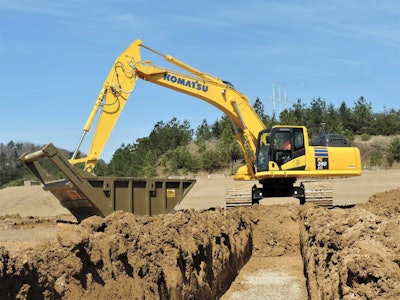 Komatsu PC390LCi-11 with iMC Photo: Komatsu
Komatsu PC390LCi-11 with iMC Photo: KomatsuHelping customers level the playing field through Smart Construction goes a long way in leveling the playing field for Komatsu, too.
If Smart Construction gains traction among U.S. contractors, it would be a big, meaningful win for Komatsu, who, as Floyd notes, faces considerable headwinds in a market where competitors like Caterpillar and Deere have influence far outside of the market for heavy equipment.
“We compete with some pretty established and, frankly, beloved brands,” he says. “Our competition has some substantial tailwinds. You can’t buy a Komatsu lawn mower. Maybe you didn’t grow up wearing a Komatsu hat.”
Though Komatsu beat the competition to market by at least a couple of years with its iMC integrated machine control solution, Floyd says competing brands were able to lessen the impact of Komatsu’s lead by seeding doubt in the minds of customers in regard to the feasibility and cost effectiveness of the technology.
“When we first started out in 2013, the way to combat the fact that we had come out with something new and different was for them to say that this was too hard, it’s not what the marketplace wants, it’s too confusing,” Floyd says. He says now that those same competitors are offering their own version of those machine control solutions, the messaging is now the opposite. “Those negative comments are gone and now they’re saying the same things we said back in 2013 about how great it is and how it’s going to help revolutionize their workplace.”
But Floyd says Komatsu welcomes the change in its competitors’ tune. With the headwinds caused by negative talk about technology now gone, Komatsu is confident that its head start, in the form of Smart Construction’s experienced and knowledgeable Technical Solutions Specialists (TSEs), will become more apparent and, the hope is, a distinguishable competitive advantage.
“There are now OEMs with their own version of (iMC) out there. But where they’re probably not going to catch up with us ever is our people,” Floyd says. “That three- or four- or five-year head start of helping customers solve problems? That experience gap can never be closed.”
“That’s where the game is really going to be played. It’s not just about the technology. If (the customers) don’t understand the technology, you’ve given them a Lamborghini and they’re only taking advantage of the cup holder.”
Different approach
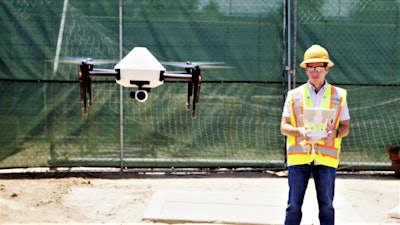 The Skycatch Explore1, a custom drone built for Komatsu, is at the center of the company’s new EverydayDrone surveying service in Japan.
The Skycatch Explore1, a custom drone built for Komatsu, is at the center of the company’s new EverydayDrone surveying service in Japan.“Construction in Japan isn’t the same as it is in the United States,” Faulhaber says, explaining why Komatsu partly acts as a high-tech site prep contractor in Japan while focusing on education, outfitting and support with its approach to American contractors.
Beyond the differences in how a site is managed or the variation between preferred machines and methods, the Japanese construction market is in the process of fighting through a severe shortage of construction workers. As the Japanese Times reports, though the country’s construction sector is “booming,” contractors are struggling to meet demand due to a lack of skilled workers. The publication cites a Shimizu Corp. study that estimates the number of construction workers in the country will drop to 2.2 million by 2025, a 35-percent drop from the 2014 number.
U.S. contractors have been staring down a similar situation for the past several years. But the U.S. construction industry, recovering from its own massive drop in workers in the wake of the 2008 financial crisis, has added workers for the last six years, albeit at a slower pace than many would like. Still, according to the Labor Department’s July estimate, there are 7.2 million construction workers employed in the U.S., up 5 percent in the last 12 months.
Plus, as Faulhaber added, though adoption of machine control technology is relatively low among U.S. contractors of all sizes, adoption is on the upswing among small- to medium-sized contractors, and is a well-established practice among the largest firms.
Faulhaber says that wasn’t the case in Japan when Smart Construction launched in 2015. Because its home country faces high construction demand, hosting the 2020 Olympic Summer games, and has a shortage of workers that continues to worsen, Komatsu went straight to full automation in Japan. There simply wasn’t enough time, or a large enough audience, to spread the gospel of semi-auto machine control.
“They have to look for more ways with which they can support their customers. In doing so, they feel that their EverydayDrone service and the automation they can provide through their cloud services and the uploads will help with the labor shortage and still ensure that the projects are getting built. Over in the United States we were a little bit further along with machine control technology and adoption, so we didn’t really have to start at ground zero like they did,” Faulhaber says.
Make it easy
Instead, Komatsu’s TSEs started with a simple and consistent refrain it had heard from customers when it comes to technology: “Just make it easy.”
“Very quickly customers started saying ‘Thank you for the intelligent dozer. I get the win from the dozer. Now show me how I can get the win on the entire jobsite,’” Anetsberger says.
Komatsu launched Smart Construction in 2016 with a new type of dealer employee trained to ‘make it easy’ by answering any questions a machine control customer might have while providing comprehensive guidance along the way.
These Technical Solutions Specialists, or TSEs, can arrange for demonstrations of iMC machines, facilitate a purchase of one of those machines, coordinate all the required peripheral hardware (such as base stations and rovers) and even guide customers in the initial jobsite setup. They’re also available to assist in troubleshooting, digitize site plans and introduce customers to drone surveying.
“Smart Construction is really delivered onto the jobsite. That’s a key thing,” Anetsberger says. “To have people that can go to the jobsite, talk to the customer, identify some of these pain points and areas of opportunity and deploy some type of solution.”
Over the past three years Faulhaber says he and his team at Komatsu Equipment have been working to earn a particular reputation among Smart Construction customers. Rather than just being seen as technical support for heavy machinery, he and his team hope to be seen by contractors as a business partner assisting them in all things pertaining to digital jobsite efficiency.
A big step in that direction, due to the huge amount of data the technology taps into, has been expanding Smart Construction’s ability to act as a consultant for aeromapping, as Anetsberger calls it, or 3D modeling and drones.
More Tomorrow: In part two of this series, we explore the expansion of Smart Construction, including Komatsu’s partnership with drone analytics company Propeller.




